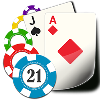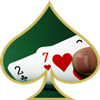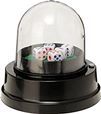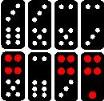- Online Casino Games Guide
- Best Online Casinos
- Online Casino Reviews
-
-
-
Online Casinos by Country
Click your country on the map to find a list of the best online casinos accepting players from your country
Click the (+) on the up-left side to enlarge the map, then move the map with your mouse to focus on your country.
-
-
-
-
-
Search something on CasinoPoker.co
-
-
- Casino Guest Post
Double Exposure Blackjack
Double Exposure Blackjack, rules and strategies
Double Exposure blackjack (or ‘Zweikartenspiel’ in its original German version) was invented by Richard. A. Epstein. This variant of blackjack begins when the dealer receives 2 cards (face up) during the initial shuffle. This game configuration gives many useful indications to the player.
However, be aware that the payout associated with natural blackjack is 1 to 1 (instead of 3 to 2) so that the house retains an advantage. In addition, the player will lose his bet if his hand is equal to that of the dealer. Since the dealer’s cards are perfectly visible from the start of the game, you will not be able to take out blackjack insurance or give up your hand.

Blackjack Articles 2025
- How to choose the best location at a blackjack table
- The best blackjack movies
- How to Play Blackjack: Blackjack Rules
- Blackjack Martingale
- Mobile Blackjack
- Live Blackjack
- Blackjack strategies
- The 25 best books on blackjack
- Actions: split, double, surrender
- The stars of blackjack
- Blackjack Insurance
- Winnings in Blackjack
- Top Blackjack Variations
How to play Double Exposure blackjack?
Double Exposure blackjack rules
In addition to the description provided in our introductory paragraph, Double Exposure blackjack obeys other additional rules which differ from traditional online blackjack. Here are some of them:
- The dealer may decide to draw an additional card on a soft 17 or remain in his positions;
- The player can choose to double or not his initial bet after having made a split;
- The player can split his cards one or more times (it all depends on the conditions of use associated with the game).
Finally, the rule that switches the odds in favor of the house and governs the equality between the player and the dealer. In the event of a tie between the two opponents of the game, the croupier wins (except in the case of natural blackjack). If this rule did not exist, the player would have a significant advantage over the house.
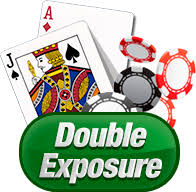
Double Exposure blackjack summarized
- Players are able to view the two dealer’s cards;
- The dealer can draw an additional card on a soft 17;
- A natural blackjack is associated with a payout of 1 to 1 (and no longer 3 to 2).
Why play Double Exposure blackjack?
Although Double Exposure blackjack allows the player to make much better decisions, it is impossible to avoid the fact that the addition of new rules will have contributed to increasing the house advantage. To make it decrease and start generating gains, it is imperative to apply a foolproof strategy. By doing so, you will be the master of the game!
Let us take a concrete example to support our remarks: imagine that the player has a hand of 19 points and that the croupier holds a hand of 20 points. In the traditional blackjack, if a player is lucky enough to hold a 19-point hand, it would be really unadvised to draw an additional card (not knowing the dealer’s second card).
In Double Exposure blackjack, if a player has a hand of 19 points and the dealer has a hand of 20 points, it is better to take the risk of drawing another card rather than resigning yourself to a loss.
The main advantage of Double Exposure blackjack is that players have the ability to make much more relevant decisions based on the dealer’s 2 cards. There are also more difficult sides to manage (like the croupier who is authorized to draw an additional card or to camp on his positions on a soft 17).
It also depends on the conditions associated with the game in question. Generally, a tie in blackjack is to the advantage of the player. In other versions, this scenario is considered a tie and comes to the advantage of the player. When registering in the online casino and starting a game of Double Exposure blackjack, make the effort to find out about this last point to avoid unpleasant surprises.
Where to play Double Exposure blackjack online?
Microgaming
Few Online Casino Fans Have Never Heard of Microgaming. Although Microgaming does not accept players geolocated in the United States, the company provides its services to more than 250 online gaming sites scattered around the world.- On the version offered by Microgaming, 8 decks of cards are used.
- The dealer wins all ties, except in the case of blackjack (natural or not).
- The payout of blackjack is 1 to 1 (not 3 to 2 like the other game variations). Microgaming’s Double Exposure blackjack payout table is one of the easiest to memorize for the good reason that all wins are paid 1 to 1.
- You can split your hands and play with up to 4 hands.
- You can also double your bet immediately after a split. If you choose to split your aces, you can only receive one additional card per hand.
Realtime Gaming
You can also play Double Exposure blackjack at Realtime Gaming casinos. They call it ‘Face Up 21’ to distinguish themselves from their main competitors, Microgaming and Playtech. Realtime Gaming has had a rather turbulent history due to the UIGEA law, promulgated in 2006 in the United States. Despite having started in Atlanta (Georgia), Realtime Gaming made the decision to sell the company to Hastings Limited, a gaming company operating in Curacao (in the Netherlands Antilles).'Double Exposure' Blackjack Strategy Table
Our table is based on the rule according to which the dealer can draw an additional card on a soft 17.
An important point for those playing Double Exposure blackjack for the very first time: as long as the value of your cards is less than or equal to that of the dealer, you obviously have to draw an additional card to try to defeat it.
For example, if you have a pair of 10s and the dealer also has one, you will need to draw another card. Even if your chances of drawing an ace are minimal, you are forced to do so since the dealer wins the round in the event of a tie.
Same remark when you have a hand whose value is lower than the dealer (between 17 and 20). If you give up drawing an additional card in this specific case, it’s as if you give up the fight without even resisting it. You have absolutely nothing to lose in situations like these!

